November 2017 | view this story as a .pdf
1 & 2. Earth Angels
Mother and daughter Hawa Ibrahim and Khadija Hussein cultivate a new life in Maine.
By Sarah Moore
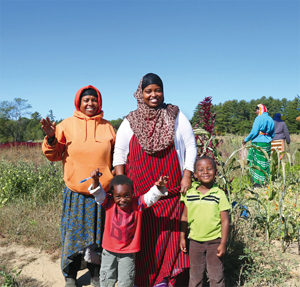 Khadija Hussein, 22, sits in the long grass beside rows of colorful chard and heads of lettuce, neatly planted over this slice of the Packard-Littlefield Farm in Lisbon. The sun is bright, and the morning is already hot, though the yellowing corn warns of the season’s end. This farmland is owned by Cultivating Community and farmed by members of the New American Sustainable Agriculture Project. Khadija’s mother, Hawa Ibrahim, 56, was one of the first to join the program in 2006, after leaving Kenya with Khadija and her six other children for a new life in America. The family arrived in Dallas, Texas, at the end of 2005, where they stayed for a short time with the support of the International Rescue Committee. “After four months, we were on our own,” Khadijah says. “We didn’t know what to do. We didn’t have a car or even a driving license, so how could my mom get a job? A relative told us to come and join them in Maine.” She shakes her head, then laughs. “We traveled for three days to get here. Dallas was hot, so we arrived in flip-flops. It was early March. The snow was so high. I cried and cried to my mum: ‘You made me take the bus for three days to torture me like this?’ I’d never seen snow like this before.”
Khadija Hussein, 22, sits in the long grass beside rows of colorful chard and heads of lettuce, neatly planted over this slice of the Packard-Littlefield Farm in Lisbon. The sun is bright, and the morning is already hot, though the yellowing corn warns of the season’s end. This farmland is owned by Cultivating Community and farmed by members of the New American Sustainable Agriculture Project. Khadija’s mother, Hawa Ibrahim, 56, was one of the first to join the program in 2006, after leaving Kenya with Khadija and her six other children for a new life in America. The family arrived in Dallas, Texas, at the end of 2005, where they stayed for a short time with the support of the International Rescue Committee. “After four months, we were on our own,” Khadijah says. “We didn’t know what to do. We didn’t have a car or even a driving license, so how could my mom get a job? A relative told us to come and join them in Maine.” She shakes her head, then laughs. “We traveled for three days to get here. Dallas was hot, so we arrived in flip-flops. It was early March. The snow was so high. I cried and cried to my mum: ‘You made me take the bus for three days to torture me like this?’ I’d never seen snow like this before.”
Hawa had farmed the family’s land in Africa until war and persecution of Somalis drove them out. “We had a farm there. Animals, land, a cool lake to jump in when it got too hot. We left all that behind. Soon after our arrival, my mom attended a meeting at Lewiston City Hall,” where applications to a farming program were circulated.
Hawa was one of the only refugees not to throw the application away immediately. “Everyone else was too scared to sign up,” Khadija says. “They thought it was dangerous. That we’d be taken out into the fields and killed or something.”
Meanwhile, Khadijah and her siblings, who are now scattered across the country from Ohio to Texas, went to the local elementary and then to middle school. “I had a teacher in Texas for a couple of months who helped me learn some English, but no one knew what to do with us at my new school. I spent two years coloring and watching TV.” She was eleven. “One day, I turned to my mom and told her I hated waking up to do nothing every day. I slept all the time; I had no purpose. My mom was furious. She drove to the school and screamed at the teachers, the principal. She wouldn’t stop until they got a translator and listened to what she had to say. She came here for a better life for her children. She wasn’t going to let us sit and watch TV all day.”
By the end of sixth grade, Khadija was finally getting support. “Once I started to learn, I started to enjoy it.” She began taking after-school homework groups and staying in the library to catch up. By sophomore year she was in mainstream classes. But her ESL classes at Lewiston Middle School showed her the challenges kids like her faced in the system. “One teacher gave us a ten-page book and made us read the same sentences over and over for the whole year. We were teenagers. We weren’t learning anything! The parents complained. The head of the department came in one day, furious. She slammed a big, complicated book on the table and said, ‘You want a challenge? Here you go.’” Like Hawa, Khadija wasn’t afraid of making her voice heard. “I told her I just wanted to learn. I wanted someone to actually teach us something.” Despite a late start and significant interruptions, in 2013, Khadija graduated with her year group. That summer, she attended a career course for teaching and enrolled at Central Maine Community College.
As she talks, a flying figure leaps over her shoulder, catapulting into her lap with a roar. Her sons Muhammed Aden, 4, and Iiyase Aden, 3, are tireless, capering balls of energy. They dance among the rows of vegetables, springing back to show off a handful of milkweed or field daisies. Now that she’s put down roots, does Maine feel like home? “Yes and no. I’ve been here a while, and I know it well. I know where to turn if I need help. But at the same time, there’s always someone to remind you this is not your home.”
She recalls a class vacation in high school, when she and a friend walked into a grocery store. They both wore hijabs. The store fell silent as the girls entered. “My friend told me we should just run, leave. I said, ‘Why should I? I haven’t stolen anything. Why are they staring like we’re aliens?’” This same streak of courage would make Khadija turn to confront hostile children at school who’d tell her she didn’t belong and that her family was just here to collect food stamps. “I’d say, ‘Yes we do belong. And you’re taking food stamps, too. But we’re here because war drove us from our country.’” Despite her youth, you get the impression you’re in the presence of a tireless force of will.
Khadija will go back to CMCC to finish her degree this winter. She’ll continue to help Hawa with the farm, selling the last of the fall harvest. Mother and daughter sell their produce at farmers’ markets, pantries, schools, restaurants, and CSA shares through Fresh Start Farm food hub. She’ll also cook for Viles Arboretum, the Augusta market stand where she and a group of women sell Somali food. Looking ahead, Hawa dreams of a farm and land of their own where she can raise animals and crops. “We’re trying to save for a home and some land,” Khadija says. “I hope for more than we have now. More for my boys.”
3. Arctic Star
The climate change Angus King fears is the very reason behind an emerging Northwest Passage. The risk-taker in him is ready to jump at the opportunity.
By Sarah Moore
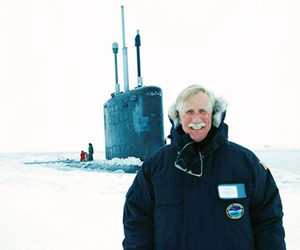 Even when he’s in Washington D.C., Senator Angus King has one foot in Maine and his eyes on the Arctic Circle. The former governor and Maine’s first Independent U.S. Senator believes melting ice caps could open the way for Maine to become the U.S. gateway to the Arctic and the Far East beyond. We caught up with King during his travels around the state to discover what lies beyond the horizon for Maine and the Arctic.
Even when he’s in Washington D.C., Senator Angus King has one foot in Maine and his eyes on the Arctic Circle. The former governor and Maine’s first Independent U.S. Senator believes melting ice caps could open the way for Maine to become the U.S. gateway to the Arctic and the Far East beyond. We caught up with King during his travels around the state to discover what lies beyond the horizon for Maine and the Arctic.
It’s been a year since Portland hosted a meeting of the Arctic Council. Did it break any ice?
It was a big deal because it literally put us on the map in matters of the Arctic. Heretofore, nearly all these meetings had taken place in Scandinavia, Alaska, or Canada. There’d never been anything on the East Coast of the U.S. It was a symbolic recognition by this multinational organization that Maine is now a part of the Arctic discussion.
Did it change things in Maine?
We’re already seeing the most tangible effect of this engagement in our relationship with Eimskip. [The number of containers passing through Portland’s ports has tripled since 2013, and Eimskip plans to introduce a weekly shipment by 2020.] I saw Eimskip trucks out on the road during my motorcycle trip in central Maine this summer. That felt significant for me. I think a wonderful symbolic gesture of this burgeoning relationship came when the Maine Brewers’ Guild sent a container load of beer up to Iceland. So many people asked me about Arctic development during my travels throughout Maine. I’ve seen a deepening interest in this issue among the Maine public.
Does this mean we really are “the gateway to the
Far North?”
Realistically, we’re talking about progress that will take place over the course of decades–anything from 15 to 30 years to develop the infrastructure and work out the insurance and trade details. That being said, the melt is happening faster than we predicted. The volume of ice in the Arctic Ocean has declined by two thirds since 1979.
How do you align your two perspectives as an advocate of Arctic opportunities but also an environmentalist? Is it bittersweet?
I’ve spent a great deal of time working on climate-change issues, trying to alert people to the risks. There’s no doubt most of the effects of climate change will be negative. And, of course, a sea-level rise is going to have a huge impact on a coastal state like Maine. But one of my main principles in life is that you have to play the hand that’s dealt to you. The reality is, of all these negative effects, the opening up of the Arctic creates new opportunities. We’re facing an extraordinary moment in human history. I’ve likened it to the discovery of the Mediterranean Sea: A body of water that has been completely closed to major human activity throughout history is suddenly available for transit, for energy, commerce, and recreation. I don’t feel like I’m betraying my concern over climate change by engaging with this. I think, if this is happening, what are the implications–good and bad–for Maine?
What makes us so perfectly poised to lead the U.S. into the Arctic?
Eastport, Searsport, and Portland are the three closest U.S. ports to the Arctic. Eastport has around 65 feet of depth just a few feet from shore. New York would kill for that!
What are the challenges we face on a national level? You’ve spoken with conviction of the need for more heavy icebreakers.
The icebreaker is essential infrastructure, and we’ve just woefully neglected it. The best way to think of it? Icebreakers are like the interstate highway of the Arctic. Right now, we’ve only got one and a half. The half is a ship that we’re using for parts! It’s embarrassing. Meanwhile, the Russians have an estimated 17 to 40, including several nuclear-powered ships. It’s like we’re traveling on old country roads, and they’re zooming along highways.
So this is the new Space Race? The Arctic Race?
Well, if we’re talking about transit and commerce opportunities, infrastructure makes a huge difference. And there’s an issue of security. Without getting into anything classified, the Russians have made significant steps into the militarization of their Arctic fleet in terms of bases, ports, and assets. I should say that the Arctic is one area where we have actually been able to work cooperatively with the Russians! It’s a bright spot in our relationship.
How soon will we see results? Will Bath Irons Works stand a chance of winning the contract?
[The Senate Defense Appropriations Subcommittee added $1 billion to fund the creation of a new icebreaker in 2016. China, a non-Arctic Nation, recently allocated $300M toward its second icebreaker, according to Global Trade Magazine.] I think there are going to be serious steps toward creating icebreakers in the next few years. We really need a multiple procurement, and it needs to happen soon. The major issue is how much it’ll cost. We’re trying to get to the bottom of how countries like Finland are doing it for half a billion. As for Bath Iron Works–perhaps.
You were the only Congress member to join a fact-finding mission to Greenland in 2016. What did you learn on the trip?
Yes, that’s right. On a previous Congressional trip to Pakistan, I met a very old man who took my hand and said, “I know why you’re here. You’re here because you understand that a day of seeing is worth more than a month of reading.” I found that to be very profound and quite true. I went to Greenland with the Commandant of the Coast Guard to conduct research in national security and climate change. We met with the Danish Navy, who run Greenland’s military and foreign affairs, and went out on their frigate with two American climate scientists, John Englander and Bob Corell–who actually summers in Maine. Corell was visibly shaken by what we saw. It’d changed so much in the two years since he’d last visited. But like I said, you play the hand that’s dealt. Greenlanders are gaining land for farming and grazing from the retreating ice sheets, while also losing their old ways of life. They feel it’s a double-edged sword.
In your opinion, what are the chances of an Independent President of the United States?
[Laughs] I think it would be very difficult. The time may come, but it’d be very, very difficult!
4. The Look
The camera loves Maine’s emerging star Yamilah Saravong in the holiday hit movie Daddy’s Home 2.
By Jeanee Dudley
 Actress, model, honorary member of Mark Wahlberg’s entourage–these are unexpected aliases for a small 11-year-old bouncing a soccer ball around a field in her white-and-blue uniform.
Actress, model, honorary member of Mark Wahlberg’s entourage–these are unexpected aliases for a small 11-year-old bouncing a soccer ball around a field in her white-and-blue uniform.
Yamilah Saravong lives in York with her parents, brother, and two dogs. Earlier this year, she spent two weeks in Western Massachusetts filming Daddy’s Home 2 with co-stars Wahlberg, Will Ferrell, Mel Gibson, John Cena, and John Lithgow.
Yamilah’s first gig came when she was five years old, appearing in Miss Saigon at Ogunquit Playhouse, where she continues to act year after year. “Every summer I do a kid’s camp there.” She still remembers her first speaking part. “South Pacific. It was ‘The boat!’ four times before running across the stage.”
Before Daddy’s Home 2, she’d only acted on camera for a Lifespan Health commercial and a PSA. Jill Saravong, Yamilah’s mother, says luck played a hand in her audition. “Movie work is so competitive,” Jill says. “The filmmakers were very specific. They wanted someone already living in New England, of a certain age, height, and look.”
Yamilah got a callback. After the second round of auditions, her mom received an email from their agent saying the filmmakers wanted her for the role and were awaiting final approval from Paramount Pictures.
“She printed the email out and told my dad first, so they could film my reaction,” Yamilah says. “They gave me the paper. I started reading and didn’t get what it said at all, so I didn’t get excited. I was like, ‘So…yes?’ My mom was like, ‘You got it!’ And I was like, ‘Cool!’ Then I called all my friends.”
Her favorite scene is one she filmed with Will Ferrell. “I memorized the whole script–that’s part of what I had to do for the audition–but then Will Ferrell started doing improv, and I didn’t know what to say at all! It was only my second day.”
Yamilah loved life on set. She waxes lyrical about a food truck with drawers full of candy and gum, and a magical catering company that would prepare anything she wanted for breakfast. The crew made her feel important, but more surprisingly, the stars were warm and friendly. “Mark [Wahlberg] was great with the kids,” Jill says. “When Yamilah would slip away from the set and return, he’d notice and say, ‘Hey, you’re back!’”
“He gave me a ‘Wahlberger’ hat,” Yamilah says, referring to the uniform of Wahlberg’s entourage, which includes “Rasta Phil” and a stuntman named Cowboy.
Between scenes, Mel Gibson told the kids jokes, and John Cena signed autographs for the young actors and all of their friends and siblings back home.
As for the future, Yamilah shrugs. “I’d have to think about that,” she says. “I don’t really know. I hope to do another movie because they’re really fun. I just want to see where it takes me. It’s a different road every week!”
She’d like to visit Los Angeles and Bora Bora, but she doesn’t want to move out of Maine. “I recently did an audition for Nickelodeon. If I got it, we’d go there just to film, then come back if they need us a couple weeks later,” she says. “I could still be with my friends, be home, go to my school.”
Daddy’s Home 2 is playing now in movie theaters.
5. Undaunted
There are five quadruple amputees who survived their injuries from the Iraq and Afghanistan Wars– Travis Mills is one of them.
By Julia Tolstrup
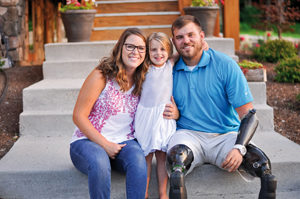 If you ask Travis Mills about the word hero, he’ll tell you that it doesn’t apply to what happened to him. “I just had a bad day at work.”
If you ask Travis Mills about the word hero, he’ll tell you that it doesn’t apply to what happened to him. “I just had a bad day at work.”
That bad day came on April 10, 2012, during his third tour in Afghanistan. Mills dropped a bag on the ground by his side, setting off an Improvised Explosive Device (IED). In that moment, his life changed forever. There are five quadruple-amputees who survived their injuries from the Iraq and Afghanistan Wars–Travis Mills is one of them.
Over the next 19 months, Mills relearned how to live. Returning to the U.S., he faced the long road to recovery at Walter Reed Military Medical Center in Maryland with his wife, Kelsey, and daughter, Chloe, by his side. Those early days were dark and difficult. Mills suffered from severe phantom limb pain as he healed and then learned to adjust to life with four prosthetic limbs. Mills told his wife to take their assets and start a new life without him. She refused. Slowly, he began to find his way. Chloe, just six months old at the time, became his guiding light.
“When I got injured I was pretty down on myself, unsure whether I could still be a productive father and husband. Seeing my daughter every day made life better.”
Mills strapped Chloe in a wheelchair with him, and the two visited other families around the hospital. He came to be known as the Mayor of Building 62.
“My daughter is one of the biggest reasons I was able to get better. We got to learn how to walk together.”
Finally, Mills and his family were able to return to Manchester. After all the support they’d received at Walter Reed, Travis and Kelsey felt compelled to pay it forward. The two considered launching a care-package charity for deployed soldiers.
“People in Maine saw I went kayaking, downhill mountain biking, and snowboarding. They suggested I bring some of my friends out to Maine to try adaptive sports.”
Mills began hosting wounded soldiers and their families Camp Kennebec in North Belgrade. Very quickly, things outgrew the capacity of Bread of Life Ministries, the non-profit supporting them at the time
“It got too big for them to handle. My wife and I decided right then this was too important to pass up.” The Travis Mills Foundation was born.
There was a time when Elizabeth Arden’s Maine Chance Spa brought the likes of Judy Garland and Ava Gardner to the Belgrade Lakes region. Well-heeled Manhattanites regularly attended to indulge in expensive spa treatments and dabble in hula-hooping classes. During the Depression, the spa employed hundreds, all here to pamper the rich and famous.
Today, through the efforts of the Travis Mills Foundation, the former spa has undergone a $3 million renaissance to become The Maine Chance Lodge and Retreat. Here, combat-wounded veterans and their families come to relax and enjoy boating, paddle boarding, equine therapy, fishing, and more. No one is excluded.
“We make sure that if there are veterans with a disability, they can do everything right alongside their family.”
Mills has come a long way from the battlefield. He and Kelsey recently welcomed a son, Dax, whose name is a combination of Daniel and Alexander, the two medics who saved Mills’s life after the bomb exploded. Chloe, now six, is a big sister and the apple of her father’s eye. During Maine Chance Lodge’s inaugural summer of 2017, the retreat hosted “56 military families.” For Mills and his family, it’s the start of something new.
6. Globe Trotter
From Maine to the Mongolian steppes, Amanda Charlton Herbert chases adventure–on four legs.
By Sarah Moore
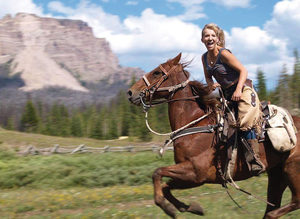 Amanda Charlton Herbert was eight the first time she tagged along to the therapeutic horse-riding program where her mother volunteered. She remembers helping to brush and lead the horses, feeling no fear as a small child among the large creatures. By 12, she was being paid to train horses to jump. “One of my first instructors told me I was an instinctual rider, whatever that means,” Herbert says. Ten years down the line, she was competing full-time on the hunter jumper circuit while juggling classes at NYU. But as her burgeoning career gained momentum, Herbert became disillusioned with the entire business. “I was working so hard to get far on the circuit. The whole thing became so ego-driven and focused on winning. I lost sight of my horsemanship, of why I got into it in the first place. So I quit college and the competition circuit and moved out to Wyoming to work on a guest ranch,” she says and laughs. “I guess you could call it my quarter-life crisis.”
Amanda Charlton Herbert was eight the first time she tagged along to the therapeutic horse-riding program where her mother volunteered. She remembers helping to brush and lead the horses, feeling no fear as a small child among the large creatures. By 12, she was being paid to train horses to jump. “One of my first instructors told me I was an instinctual rider, whatever that means,” Herbert says. Ten years down the line, she was competing full-time on the hunter jumper circuit while juggling classes at NYU. But as her burgeoning career gained momentum, Herbert became disillusioned with the entire business. “I was working so hard to get far on the circuit. The whole thing became so ego-driven and focused on winning. I lost sight of my horsemanship, of why I got into it in the first place. So I quit college and the competition circuit and moved out to Wyoming to work on a guest ranch,” she says and laughs. “I guess you could call it my quarter-life crisis.”
Life realigned for Herbert among the mountains. “I fell in love with the endless expanse of nature, the wilderness, the whole magic of it, and I realized this was how I wanted to live my entire life.” In the years that followed, she traveled and worked across the Midwest for seasons at a time, always returning to her parents’ home in Poland. “It’s my favorite place. I see myself settling in Maine, near my family.” A faint lilt in her accent and the occasional ‘ma’am’ belies her time in the Wild West.
It was in 2016, while working on a ranch in Colorado and living “in a tiny cabin with no water or electricity,” that Herbert first got the idea to enter an endurance horse race. “Another rancher told me about a girl he knew who’d done the Gobi Gallop. I chose the Mongol Derby because it’s the world’s longest and toughest horse race. I thought, ‘If I’m going to do this, why not really go for it?’” She returned to Maine to prepare for the race, even running the Kennebunk Marathon “to get in the mindset for endurance.”
The Mongol Derby, launched in 2009, recreates the infamous postal route established by Genghis Khan in 1224. Riders traverse over 600 miles of vast, uninhabited steppes, mountains, rivers, and forests. The Mongolian mounts they ride are quite different from the thoroughbred jumpers that Herbert trained and rode in competition at home. “They’re semi-wild. Nine times out of ten, your horse would have a bucking fit as soon as you put the saddle on its back. Then you have to endure another round of bucking once you mount.” Like Khan’s postal messengers of the 13th century, riders change horses every 25 miles, camping out under the stars at night or staying with the scattered local herders. “I remember sitting in a herder’s hut and crying to an old Mongolian woman. She didn’t speak a word of English, but she sat there and listened to me, comforted me,” Herbert says.
Herbert joined a field of 40 experienced riders whittled down from hundreds of applicants. Armed with GPS systems, they were released into the Mongolian wilderness to forge a path along the network of support systems that stretched across a swathe of virtually uninhabited land. “Someone told me that only one percent of Mongolia is inhabited,” Herbert says. Even for this lone ranger, the vast emptiness of the Mongolian steppes was astounding in its scale and beauty. She’s almost breathless recalling the nine days spent mostly in the saddle with only a backpack of possessions. Feelings of pain and uncertainty rode side-by-side with wonder and excitement.
“I have memories of mounting an enormous ridge to see a vast valley spread out below. There wasn’t another person in sight.” The true weight of this isolation hit heavily at other times. “Toward the end of the journey, I was galloping across the steppes with my friend, Taylor Dolak. Suddenly I heard a death scream and looked back to see Taylor and her horse on the ground. The horse was bellowing. Then it went silent. Its legs were sticking straight out, rigamortis-style. We thought it had died. After a while, it got up again–like some kind of Lazarus horse!”
Finally, after nine days and 633 miles, she made it across the finish line.
Herbert will spend the next year training dressage horses in Utah and getting her equine massage therapy license. “I’m an artist, and I’m still drawing pieces inspired by what I saw in Mongolia. I hope to save up all my money and return to Maine in a year and buy myself a secluded cabin near the sea.” And after that? “Oh, a horse of my own, for sure!”
7. PC Guy, Maine Guy
John Hodgman loves his Maine retreat, even though “I know nothing about letting go.” In his new book Vacationland, the closet Mac owner takes our humor in the North Woods to a new level of weird.
By Sarah Moore
 By the end of 2012, John Hodgman had finished That’s All, his third book of farcical trivia and fake facts, and was awaiting the end of the world as predicted by the Mayan calendar. When the apocalypse didn’t arrive, Hodgman was alive but unsure of his next move. “I didn’t truly believe in the end of the world, of course, but if you say it enough, it starts to feel real. I went into 2013 with a terrifyingly clean slate.”
By the end of 2012, John Hodgman had finished That’s All, his third book of farcical trivia and fake facts, and was awaiting the end of the world as predicted by the Mayan calendar. When the apocalypse didn’t arrive, Hodgman was alive but unsure of his next move. “I didn’t truly believe in the end of the world, of course, but if you say it enough, it starts to feel real. I went into 2013 with a terrifyingly clean slate.”
“Clean slate” is a relative term. Hodgman pens the weekly “Judge John Hodgman” advice column for The New York Times. His podcast of the same name has broadcast for over seven years with Maximum Fun productions. He’s recognized everywhere for his regular character appearances on The Daily Show with Jon Stewart. But personal projects had stalled. “I felt out of material. Like I didn’t have any stories to tell. I started comedy residencies at the Union Theater and the Bell House in Brooklyn. There’s nothing like knowing there’s an audience waiting to hear you speak to draw out stories and ideas. Panic catalyzes creativity.”
During these performances, “apart from a good Ayn Rand imitation,” Hodgman found himself avoiding the impersonations and absurdist comedy that had characterized his previous work. He retired the ‘Deranged Millionaire,’ a beloved Daily Show character modeled on pre-presidential Donald Trump, and dreamed of a hiatus from the nonsense trivia of his early books. “It’s gone sour. I feel like the market is now so saturated with fake facts. Modern culture owes me royalties for fake facts.” What tumbled out was, surprisingly, the truth: stories of family, personal incidents, “and, as trite as it sounds, impending mortality.” These anecdotes form the basis of Vacationland: True Stories from Painful Beaches, Hodgman’s latest book (Viking, $25).
Hodgman’s wife, Kathleen, is a lifelong visitor to Maine. The couple owns a “less-fancy three-bedroom house on a flat, muddy bay” in Brooklin. “The car is always running. She’s got one foot out the door ready to leave New York for Maine in a second.” Hodgman himself is originally from Brookline, Massachusetts, which provides him with the perfect perspective to examine Maine and our inhabitants with a wary fascination and respect. “We call Maine Vacationland, but it’s cold and challenging. The people who come here are attuned to nature. Maine doesn’t care if you live or die. I’m becoming more and more comfortable with that,” he says. The theme of aging and of grappling with “the dumb, awful truth” of mortality forms the dark underbelly of the book’s humor.
As “a pretentious, affected, loathsome” youth, Hodgman never set out to become a multi-hyphenated actor-comedian-podcaster. “I knew early on I didn’t want to work for a living in the traditional sense. I wanted to do as many things as I could while also being able to nap.” Writing, however, has always been “as essential as breathing but not as much fun as eating.” His nascent career in entertainment was propelled into the spotlight when he landed a role as “PC Man” in the Apple Mac adverts of the early 2000s. “It was life-changing in terms of my career and my family’s finances. Some of my happiest memories are of hanging about with Justin Long and director Phil Morrison, being creative together. We’re friends to this day.”
One chapter of Vacationland, entitled “Maine Humor,” takes place partly in Perry’s Nut House of Belfast. Hodgman stands before the merchandise, comprising “mostly of men with flinty, Downeast accents giving bad directions to people from away.” At the time, “even when work was going well, I feared it would all slip away,” he says. “That I’d end up a middle-aged man joking about Maine.” With near spasms of irony he ends the chapter, “Please put this book down for a moment to appreciate my incredible mastery of literary irony. I’ll just be over here curling into a ball, trying to disappear forever.”
8. Survivor
Maine Maritime grad Jessica Hewitt has much to teach about loss, redemption, and the sinking of the Bounty.
By Jeanee Dudley
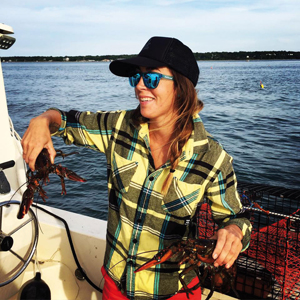 Despite her education at Maine Maritime Academy and experience as a deckhand, nothing could’ve prepared Jessica Hewitt for what she faced aboard the Bounty at the hands of Hurricane Sandy. The Bounty, a replica of the Royal British Navy HMS Bounty, was built in 1962 for the MGM movie Mutiny on the Bounty starring Marlon Brando. On October 28, 2012, as she was sailing from Connecticut to Florida, hurricane-force winds sent the 50-year-old ship below the waves of the Atlantic. Hewitt and 13 of her shipmates survived.
Despite her education at Maine Maritime Academy and experience as a deckhand, nothing could’ve prepared Jessica Hewitt for what she faced aboard the Bounty at the hands of Hurricane Sandy. The Bounty, a replica of the Royal British Navy HMS Bounty, was built in 1962 for the MGM movie Mutiny on the Bounty starring Marlon Brando. On October 28, 2012, as she was sailing from Connecticut to Florida, hurricane-force winds sent the 50-year-old ship below the waves of the Atlantic. Hewitt and 13 of her shipmates survived.
To begin with, tall-ship work is a rough gig. “Sailing is miserable,” Hewitt says and laughs. “It’s cold or it’s hot, you’re always wet, there’s no air-conditioning, and there’s no shower. It can be brutal. You stand on deck throughout your entire watch, getting absolutely pounded by the weather.”
Much has been speculated about the fateful night the Bounty wrecked off the coast of North Carolina [See our story, “Mutiny on the Bounty,” April 2013]. A 2014 U.S. Coast Guard investigation blamed the Bounty’s captain, Robin Walbridge, and the ship’s management company. But so often, the truth is more complicated than a single bad judgment call.
“I still have some anger toward Robin Walbridge,” Hewitt says. “I didn’t know it was such a big system. Often hurricanes downgrade to a much smaller weather pattern, and we all knew the Bounty had been through a hurricane before in much worse shape. But here’s the thing: I know he had our best interests in mind because he made sure we had immersion suits, which are expensive and aren’t required on an uninspected vessel. The Bounty wasn’t required to have these on board, but we had plenty. Thank goodness we did, because not as many of us would have survived if we hadn’t.”
Captain Walbridge didn’t survive the sinking. His body was never recovered.
Deckhand Claudene Christian also perished. For months, she worked eagerly aboard Bounty as a volunteer and, according to Hewitt, had been added to the ship’s payroll only days before Bounty set sail on her final voyage. “Her first pay stub was sent to her family after her death.”
Much of Hewitt’s harrowing experience on the Bounty stays with her–the loss of her shipmates, her leap from the tilting deck, the sight of the ship’s rigging crashing down on her floating crew, the feeling of being tangled in lines and pulled under. “When I was in the water, my life felt so fragile,” she says. “Like a piece of string that could be cut at any moment.”
“For three months after the sinking, I couldn’t work. Often I couldn’t get out of bed. But the tall ship community is like a big family. I survived on a combination of my savings and donations from other sailors. With encouragement from the community, I went back to a life at sea. I worked on three tall ships after Bounty, which helped me get my confidence back and manage PTSD triggers.” One of her greatest points of pride is that all her surviving shipmates from Bounty are back at work on boats.
These days, she’s focusing on her career, setting a course more suited to her degree from Maine Maritime Academy’s Small Vessel Operations Program.
“I wanted to use my license and keep upgrading,” she says. “The boat world is like the Boy Scouts. I had a lot of badges to collect.” Hewitt currently works on an oil rig supply vessel–“a comparative luxury to my time on tall ships.” She’s offshore for long periods at a time.“I don’t really have a home base. I wish I could make it back to Maine more, but I’m still close to my MMA classmates.” She’s comfortable in her current role, but she finds she faces judgment from some who learn she was a shipmate on Bounty’s last sail.
“I’ve had a lot of comments from other mariners,” she says. “They’ll say, ‘What were you thinking?’ What was Captain Walbridge thinking?’ I get defensive. I’m not proud to have been on the boat for that incident. It’s the most embarrassing thing of my career, and I don’t want to be labeled as reckless or foolish.”
The most difficult memories are still hard to shake. They visit her at the least convenient times. “When I have bad days, I know that being honest with myself and the people around me is the best course. I remind myself, ‘Keep breathing.’”
“When I’m in that dark hole, I think, ‘I survived that, and that was the worst,’” she says. “In the washing machine of these 30-foot waves and 90-mile-an-hour winds, I knew if I kept breathing, I could live. In my hard moments, I know that if I keep breathing through any challenge, I’ll survive.”
9. Dreamer
After an alarming airborne incident, Wayne Davis was inspired to put Maine back on the railway map.
By Olivia Kostishevskaya Gunn
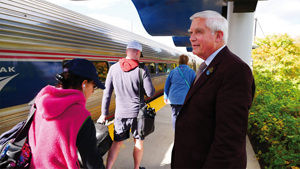 During a shuttle to Washington D.C. in the mid 1980s, Maine banker Wayne Davis felt his life flash before his eyes. “As we landed, we blew a tire and began spinning.” He turns his hand in a slow circle. Every revolution “brought us closer and closer to the terminal.” Luckily, nobody was hurt on the plane, but by the time he debouched, he felt differently about his travel options. Calling back to his Maine office, he recounted his close call to the receptionist, who’d just returned herself to Boston from Washington, D.C. by train.
During a shuttle to Washington D.C. in the mid 1980s, Maine banker Wayne Davis felt his life flash before his eyes. “As we landed, we blew a tire and began spinning.” He turns his hand in a slow circle. Every revolution “brought us closer and closer to the terminal.” Luckily, nobody was hurt on the plane, but by the time he debouched, he felt differently about his travel options. Calling back to his Maine office, he recounted his close call to the receptionist, who’d just returned herself to Boston from Washington, D.C. by train.
Now there was a blast from the past. “I rode the train a lot when I worked in Personnel in the Navy in the 1950s,” he says. “I was in uniform from 1954 to 1961.” This first fling was rekindled when he started riding the Night Owl, an Amtrak train that ran between D.C. and Boston from 1972 to 1995. The friendly dimensions of a train came back to him in a rush: “There’d always be a card game somewhere in the lounge car. The regulars who knew one another would pull out a deck of cards and play at a table in the café car.”
Next stop? A life changer, for all of us. Against insurmountable odds, Davis soon became the driving force in Maine’s Amtrak expansion
Born in Saint John, New Brunswick, Davis moved to Maine with his family when he was six months old, so he’s a local with an asterisk. “There’s a joke that a Maine native is someone who has three generations buried here and no living relatives in Massachusetts. All of my ancestors are buried in Paris Hill.”
He first took to the air regularly for work as head of Maine’s Mortgage Bankers Association of America. “I flew back and forth for the bank for years, but what do you see above the clouds? To be able to go through El Paso and look out onto the platform at Hopi Indians selling necklaces is memorable. Or to see the Great Hall of the St. Louis Union Station, with its chandeliers, stained glass, and artwork. It’s a classic. The 1930s Spanish style train station in Los Angeles is so beautiful it’s often used for commercials. Each city has something unique,” says Davis, his adventurous spirit glowing as he unrolls a map of the Amtrak System, tracing the many cross-country routes. “Before Amtrak, many Maine commuters traveled on Buddliners. They were self-propelled railway cars used as a last-ditch effort to try and preserve the train service in the 1950s. The Boston and Maine railroad had one of the largest collections. Many students said they owed their Masters degrees to the Budd cars.”
In 1989, when non-profit citizens’ organization TrainRiders/Northeast, led by Davis, began pushing for the return of a passenger rail service from Boston to Maine, they were met with their fair share of naysayers. “A lot of people said, ‘It’s too far. No one is going to commute.’ Even my friends thought I’d lost it. Today, one-third of our riders travel on passes.”
On the morning of December 15, 2001, the first Downeaster passenger train pulled out of Boston bound for Portland. Before long, the Downeaster revolutionized our urban connections. It’s changed us culturally, clearing the path for those who otherwise wouldn’t travel here. On one ride during the first year, Davis recalls spotting a young couple “dressed to the nines.” The young man was in a wheelchair. “He said to me, ‘This is the first time I’ve traveled since the accident, all because of this wonderful train,’ and then he started to cry.” The couple was headed to Boston to see the symphony that evening. It was the first time I realized this train is important to people we normally don’t pay attention to.”
The Downeaster now rolls into Portland from Boston five times a day and, since 2012, provides service to Brunswick. Ask Davis, who now lives in Topsham, how many times he’s commuted to Boston since the rail expansion and you’ll get a hearty laugh. “Too many to count!” It’s clear he never tires of it. Davis continues as Chairman of TrainRiders/Northeast and works closely with the volunteers who ride the train helping passengers navigate their travels. It’s been over 30 years since the flight that inspired a man to keep his feet on the ground and bring the train back to Maine.
10. Off the Wall
Patrick Corrigan doesn’t just think outside the box. He thinks without the box.
By Diane Hudson
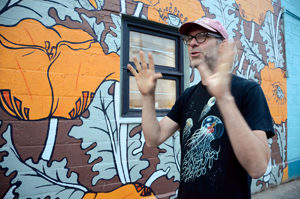 Glance around Portland and you’ll spot Patrick Corrigan’s enigmatic creations hiding in plain sight. His handiwork dances along the bar in Local 188 and across the stage at Mayo Street Arts. It’s hard to miss his studio on 107 Hanover Street. Dubbed “Fort Awesome” when he first rented it in 2004, the exterior wall sports a proliferation of poppies. Today, it doubles as the Apohadion Theater, a music and entertainment venue.
Glance around Portland and you’ll spot Patrick Corrigan’s enigmatic creations hiding in plain sight. His handiwork dances along the bar in Local 188 and across the stage at Mayo Street Arts. It’s hard to miss his studio on 107 Hanover Street. Dubbed “Fort Awesome” when he first rented it in 2004, the exterior wall sports a proliferation of poppies. Today, it doubles as the Apohadion Theater, a music and entertainment venue.
Born in Woonsocket, Rhode Island, Corrigan knew early on he wanted to be an artist. “I was very close to my grandfather. He helped raise me. He was a golden-age comic book artist in the 1930s and 40s. When I was about seven, I found these amazing comics of The Flame and V-Man in the attic. He told me he drew them. At that moment, I set my sights on art.”
Corrigan earned a BFA in illustration at Massachusetts College of Art in 1993. He moved to Portland a year later. At the time, he made a living creating commercial illustrations for the likes of The New York Times, Detroit Free Press, Chicago Tribune, San Francisco Magazine, Boston Magazine, and Amazon. He also picked up corporate commissions in Maine with Bass Shoes, LL Bean, Portland Public Market, and Funtown Splashtown.
Illustration was Corrigan’s metier until 1998, when he teamed up with Jay and Allison Villani to launch Local 188 at 685 Congress. Corrigan created the whimsical figures and details that adorn the bar and walls. He also curated a gallery of artwork to hang in the restaurant. Rubbing shoulders with a host of fine artists, Corrigan’s mind was made up: “No more illustration.” He remembers resisting calls from publications at the time. “I totally drowned that in the tub. I wanted more freedom. The deadline situation with illustrations is ridiculous–sometimes I wouldn’t sleep for two days.”
Besides occasional illustration work, like a recent album cover for The Fogcutters, painting has taken center stage. Corrigan is currently represented by Great Big Artwork Gallery. In the wild, his work can be spotted at “Local 188, LFK, Salvage BBQ, Sonny’s, 33 Elmwood, The Children’s Museum of Maine, Blyth & Burrows, Mayo Street Arts, Speedwell Gallery, and in The Bollard.”
In addition to painting, he became involved in music and performance art. “Crank Sturgeon, a performance artist I went to school with in Boston, moved to Maine. We collaborated for ten years on various performance projects. We’ve done the ‘The Sacred and Profane’ avant-garde art festival on Peaks Island for several years together. Our collaboration dovetailed into some of my painting work. He made soundtracks for my paintings, embedding a speaker in them, creating ‘sound paintings.’”
Corrigan’s other work for the festival includes a collaboration with craftsman Chris Wright. The pair collected handmade signs used and discarded by panhandlers around Portland and built a large airplane, which they dubbed the “Hoboplane.”
And then there’s Patrick Corrigan the musician. In addition to performing and recording with his band Plains, he’s working on releasing “an ambient, experimental album with a band called Jesus Cactus, featuring the great jazz drummer RJ Miller of Brunswick. Striking photographs by Black Opal, a street photographer from Japan, will make up the album artwork.” Jesus Cactus performed in the Apohadion Theater this summer.
Considering his space, referred to as “the Bayside Subterranean,” Patrick reflects on the past year spent renovating the studio and performance hall. “Building this place has taken a year’s toll on my work, but it’s finally come together. Now we’re presenting live music from near and far, movies, lectures, plays. New York filmmaker Cory McAbee is even coming to give a lecture on ‘deep astronomy’ and transdimensional travel.”
Is there anything in the creative realm he has yet to master? “Oh yes! Animation. I’d love to set some of my stories to animation. I have an idea for a kid’s show ready to go, but the way I’d like to see it would take a lot of time. But the kids, they deserve it.”





0 Comments